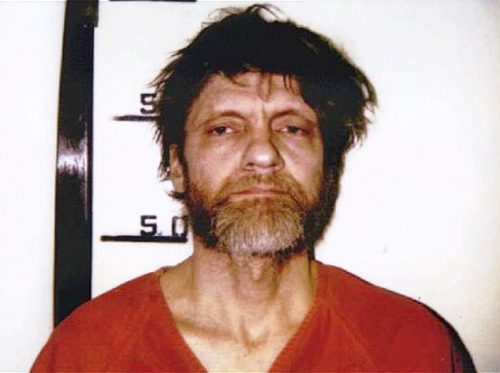Theodore “Ted” Kaczynski, nicknamed the “Unabomber,” killed and injured several people from 1978 to 1995 using mail bombs. Many experts on terrorism have difficulty in establishing whether to consider Ted a terrorist. Some believe he is simply a murderer, while others say that because of his political agenda and his decision to go after certain kinds of people, like science professors and big businessmen, that he should indeed be classified as a terrorist.1
Years before his bombing spree, in 1958, Kaczynski had been a student at Harvard University. The most astounding part is that he was only sixteen years old when he attended his first year as a freshman in college. As a child, Ted had been deemed a gifted student by his teachers. He reportedly had an IQ of 157 at the age of ten. He was allowed to skip sixth grade and work with older students, but he did not like that at all. In his journal, Ted described working with older students as considerably difficult, and he was regularly taunted by them. He never seemed to fit in. During high school, his struggle to be social continued, and he felt isolated from the rest of the students. Despite all of these problems, he still excelled academically and was allowed to skip the eleventh grade. He did have a moment of social fame which came when he made a pipe bomb in one of his science classes, but that moment of fame soon died away and he was alone again.2
During his time at Harvard, Ted continued to have extreme success academically, but still failed to be a part of the college’s social life. He lived in a single room, and some of his classmates recalled the room as messy, and that Kaczynski hardly had any interaction with any of his peers. At Harvard, he joined a study to determine the effects of extreme stress on the human psyche. The study had participants undergo extreme interrogations and personal belittlement over their beliefs and ideals. These interrogations upset Kaczynski, and he began to feel a disdain towards society and authority. According to Alston Chase, a Kaczynski researcher, Ted began to develop a theory to explain his anger and unhappiness. Chase said that, in Ted’s eyes, science and technology were destroying liberty and nature. The “system,” which included Harvard, sought to transform men into automatons to serve the machine by using techniques of behavior modification like propaganda and advertising. Unknowingly, during his undergraduate career, Ted was well on his way to becoming the Unabomber. He completed his undergraduate degree in mathematics in 1962, and went on to graduate school at the University of Michigan. He earned his master’s and Ph.D. in mathematics, and professors often described him as ambitious and talented.3
At that time, the University of California at Berkeley was considered the center of the counterculture movement, and that is where Ted decided to begin his career as a professor. He was uninterested in political activism, and failed, yet again, to become involved with those around him. He didn’t really have the talent to be a teacher and was very unpopular with students. So in January of 1969, he decided to resign his position at the end of the term. He also intended to give up mathematics altogether. His professional and social life began to spiral down after the decisions he had made.4

After his resignation, Kaczynski returned to Illinois, which was where he was born, and lived in a house owned by his parents. He was unemployed, and worked random jobs to get money, as well as borrowing money from his parents. Kaczynski was living as a hermit in the 1970s, and had little interaction with people as he began to sink deeper into his social isolation and anger. He directed all of that anger towards technology and its advancements in society. He began to write about the evils that came with technology and its control over individuals.5 During his time as a hermit, Ted decided to move to Montana where his brother lived. They split the cost of an open piece of land near Lincoln, Montana, and he began to construct a rudimentary cabin that measured 10 by 12 feet and lacked running water, electricity, and heat. Some of his neighbors described him as a quiet man who rode his homemade bicycle and spent a lot of time at the library. He enjoyed reading, and he acquired a substantial collection of volumes that filled his little home. As the decade progressed, he became more and more isolated from society. He returned to Illinois in 1978 and worked at a foam rubber factory where his brother was a supervisor. He was fired by his brother just a few weeks later, after posting insulting limericks around the factory because he had been rejected by a female plant manager. Many believe that this event was the tipping point that began his bombing campaign.6
Ted Kaczynski’s lengthy bombing campaign began on May 25, 1978, when he sent out his first bomb to Northwestern University. The box containing the bomb had a return address with the name of Professor Buckley Crist. The professor was suspicious of receiving a package that she never sent out and asked a campus officer to open it. The bomb detonated and caused the officer minor injuries. Ted then continued his campaign by attempting to bomb an airplane in November of 1979. The bomb detonated in the cargo hold and forced the place to land immediately. This attack sparked the start of a major investigation codenamed “Unabom” because of the university-based targets and the attack on a United Airlines executive.7

Throughout the span of seventeen years, the Unabomber seriously injured more than twenty-two people and killed three. One of the most notable deadly bombings was that of Gilbert Murray, a California timber-industry lobbyist. The package arrived on Monday, April 20. The first person to come in contact with the shoebox-size package was the receptionist who had trouble opening the package and carried it to her boss’ desk. At this point in Kaczynski’s bombing campaign, he had developed much more powerful and deadlier bombs that his previous ones. As Murray started to unwrap the package, it blew up in his hands. The blast killed Murray, forty-seven years old, and was so powerful it knocked two doors off their hinges and blew gashes into the ceiling panels. It was also loud enough that people heard it for blocks around. This startled and scared many people because the Oklahoma City bombing had occurred only five days earlier.8 It turns out that the bomb was never intended to kill Gilbert Murray but instead his predecessor, William Dennison. Dennison was the chief lobbyist for the forest-products trade group from 1980 to 1994 and a highly visible figure in a number of environmental issues. He was replaced by Murray who was killed by a package addressed to Dennison. At that time, William Dennison was seen as the No. 1 person in the timber industry because he was a prominent voice in the Pacific Northwest during the “the timber wars,” which involved environmentalists going up against ranchers, loggers, and the timber industry. Dennison was a key figure in the timber industry and many, including Ted, saw him as a threat to the environment, which could have been a reason why the Unabomber chose him, specifically.9

Around the time of the attack that killed Gilbert Murray, the Unabomber sent a letter to different newspapers, including the New York Times, that offered to stop his bombing spree if they published a manuscript titled “Industrial Society and Its Future,” which would later be known as the “Unabomber Manifesto.” If they did not comply, he threatened that the Freedom Club—”FC” was engraved on all his bombs—would ramp up their terrorist campaign. The manifesto ended up getting published by the Washington Post with help from Time Magazine on September 19, 1995. David Kaczynski, Ted’s brother, read the manifesto and recognized his brother’s writing style from reading unfinished copies that Ted had in his cabin. David contacted the authorities and Ted Kaczynski was arrested in April of 1996 in Montana. In his cabin, they found more than enough evidence, which included bomb-making supplies and early versions of the manifesto, to prove Kaczynski guilty. Two months later, he was charged with several criminal counts relating to the production and distribution of mail bombs. He resisted his lawyers’ efforts of declaring him insane and ended up not being able to represent himself in court. He agreed to a plea deal in 1998 to avoid going to trial. He pled guilty and was sentenced to life in prison without parole, and is still currently serving his sentence.10
- The Greenhaven Encyclopedia of Terrorism, 2007, s.v. “Unabomber, the (1942),” by Patricia D. Netzley. ↵
- Salem Press Encyclopedia of Science, 2013, s.v. “Unabomber case,” by Brion Sever. ↵
- Encyclopedia of World Biography, 2013, s.v. “Ted Kaczynski.” ↵
- Encyclopedia of World Biography, 2013, s.v. “Ted Kaczynski.” ↵
- Salem Press Encyclopedia of Science, 2013, s.v. “Unabomber case,” by Brion Sever. ↵
- Encyclopedia of World Biography, 2013, s.v. “Ted Kaczynski.” ↵
- Salem Press Encyclopedia of Science, 2014, s.v. “Unabomber” by Steve Hewitt. ↵
- Michael Lemonick and Jordan Bontante, “The bomb is in the mail,” Time, May 8, 1995, http://content.time.com/time/magazine/article/0,9171,982900,00.html. ↵
- Kenneth B. Noble, “Bombing in Sacramento: The Investigation; Bomb Meant for Predecessor Of Victim, Officials Say,” The New York Times, April 26, 1995, https://www.nytimes.com/1995/04/26/us/bombing-sacramento-investigation-bomb-meant-for-predecessor-victim-officials-say.html. ↵
- Encyclopedia of World Biography, 2013, s.v. “Ted Kaczynski.” ↵



111 comments
Sabrina Hsu
I’ve hear of the name “Unabomber” before, but I never knew what it was or what the story was. It’s so sad that Ted Kaczynski had so much potential from such a young age, but instead of helping him, it destroyed him. I was also really surprised that it was his brother that was finally able to identify him to the police. It’s scary to think something like this can happen at any time, but hopefully this won’t happen ever again.
Lorenzo Rivera
This article was extremely informative and well written. It did a fantastic job at describing the life of Ted Kaczynski, and how he went from a student at Harvard University to a very dangerous criminal. It is surprising to see how someone who seems normal, and has a promising future turn to a life of crime. This is a prime example of when a serious mental illness goes untreated, and should serve as a reminder for years to come.
Maisie Favila
I never heard about Ted, but this article caught my attention from the get-go. Not only was the article interesting, the photos were really cool. Personally, I believe he should be considered a terrorist. There isn’t any reason that he should be identified as a just a murderer. Despite all the information this article provided, there is so excuse for his actions regardless of his ‘damaged past’. Overall, this article was well written and I enjoyed learning about Kaczynsk.
Roman Olivera
Ted Kaczynski definitely stuck fear in the hearts of many Americans with the threat of attack from a person who law enforcement could not identify. This man was one of Americas first homegrown terrorist. I’m glad this man was finally identified and stopped from reigning down the fear and destruction on many more innocent people. His brother and his wife were definitely the heroes in this story for turning information in on him eventually leading to his capture. That Unibomber drawing will go down as a composite we will always remember and think of the terror that was caused in America.
Daniel Linstead
This article did a good job of describing how Ted Kaczynski went from getting a PhD from Harvard to doing horrible crimes. I just can’t wrap my head around the fact that someone with a the brains and the education Ted Kaczynski had to someone that wanted to cause so much harm to innocent individuals. I really enjoyed reading this article due to the fact I didn’t know about Ted Kaczynski until today.
Lamont Traylor
The Unabomber is another example of how people can be cowards and end innocent lives for no reason. He is no different than the people who carry out school shootings, bombings and other mass shootings and terrorist acts. They should not be publicized or made famous because that is what they want. They need to be punished to the full extent of the law and they should feel the pain that their victims felt.
Daniela Cardona
I have heard the name “the Unabomber” time and time again. I knew more or less the story of his crimes, but never any details or exact information. To think he went through so much trouble of making each bomb and coming up with elaborate plans of how and when to set them off is kind of crazy. On top of that, the fact his brother turned him in blows my mind. Of course, I am sure anyone would do the same. To turn in blood, for life, takes a lot. Also, I had no idea the focus of his hate was with technology. This is weird because it takes technology and engineering to build a bomb.
Katherine Watson
For someone with so much potential to be such a significant aspect in their specialty (for his mathematics), it is such a shame that he felt so alone mentally that he had to resort to harming others for him to feel whole, or essential. I can not fathom how someone could want to hurt others because of the self-inflicting pain they have within themselves. I am a firm believer that someone’s past should not be a good enough justification for someone to cause harm to others (nothing ever will), but maybe if something along his journey would have been different. If he would have found his niche in college, if he were better accepted, if he actually would have enjoyed his job as a professor, maybe his fate would have ended differently.
This specific form of attack reminds me of those Texas mail bombings that occurred last year that spooked everyone and harmed more than another could have imagined. I am a very dedicated user of Amazon since I have prime and I literally wanted to cancel my subscription because I did not want that white Amazon truck coming by my house anymore. We have so little security in this world, and it is scary to think that we have to put our guard up when it comes to our postal service because someone else wants to inflict others.
I hope that Ted Kaczynski has had the time to understand and critically process the pain he has caused to others.
Didier Cadena
This was a very interesting article. I was aware of the story of the Unabomber, so it was nice to see an article about him. I was however, unaware of how he got his nickname. I liked how you included the events that helped break him. The article does a great job of putting all of the information together and still make it interesting to read.
Caden Floyd
I have always heard people talking about the “unabomber” or mentioning his name, but I have never actually known what the story was. It’s crazy too think that a man with a possibility for such a bright future can end up like this. I guess he was just too mentally weak and went a little crazy after being picked on for his superior intelligence. I found this article very fascinating and thrilling to read.